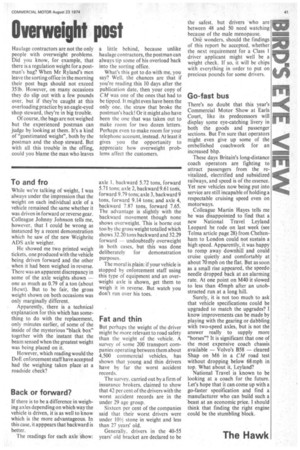To and fro
Page 45

If you've noticed an error in this article please click here to report it so we can fix it.
While we're talking of weight, I was always under the impression that the weight on each individual axle of a vehicle remained the same whether it was driven in forward or reverse gear. Colleague Johnny Johnson tells me, however, that I could be wrong as instanced by a recent demonstration which he saw of the new Weighrite ADS axle weigher.
He showed me two printed weigh tickets, one produced with the vehicle being driven forward and the other when it had been weighed in reverse. There was an apparent discrepancy in some of the axle weights shown — one as much as 0.79 of a ton (about 16 cwt). But to be fair, the gross weight shown on both occasions was only marginally different.
Apparently, there is a technical explanation for this which has something to do with the replacement, only minutes earlier, of some of the inside of the mysterious "black box" together with the instant that the beam sensed when the greatest weight was being placed on it.
However, which reading would the DoE enforcement staff have accepted had the weighing taken place at a roadside check?
Back or forward?
If there is to be a difference in weighing axles depending on which way the vehicle is driven, it is as well to know which is the more advantageous. In this case, it app pears that backward is better.
The readings for each axle show: axle I. backward 5.72 tons, forward 5.71 tons; axle 2, backward 9.61 toris, forward 9.79 tons; axle 3, backward 9 tons, forward 9.14 tons; and axle 4, backward 7.87 tons, forward 7.65. The advantage is slightly with the backward movement though none shows overweight. This is borne out too by the gross weight totalled which shows 32.20 tons backward and 32.29 forward — undoubtedly overweight in both cases, but this was done deliberately for demonstration purposes.
The moral is plain: if your vehicle is stopped by enforcement staff using this type of equipment and an overweight axle is shown, get them to weigh it in reverse. But watch you don't run over his toes.
Fat and thin
But perhaps the weight of the driver might be more relevant to road safety than the weight of the vehicle. A survey of some 200 transport companies operating between them about 4,500 commercial vehicles, has shown that young and thin drivers have by far the worst accident records.
The survey, carried out by a firm of insurance brokers, claimed to show that 42 per cent of the drivers with the worst accident records are in the under 29 age group.
Sixteen per cent of the companies said that their worst drivers were under I01/2 stone in weight and less than 27 years' old.
Generally, drivers in the 40-55 years' old bracket are declared to be the safest, but drivers who are between 48 and 50 need watching because of the male menopause.
One wonders, should the findings of this report be accepted, whether the next requirement for a Class 1 driver applicant might well be a weight check. If so, it will be chips with everything in order to put on precious pounds for some drivers.
Go-fast bus
There's no doubt that this year's Commercial Motor Show at Earls Court, like its predecessors will display spme eye-catching livery in both the goods and passenger sections. But I'm sure that operators might even give up some of the embellished coachwork for an increased bhp.
These days Britain's long-distance coach operators are fighting to attract passengers from the revitalized, electrified and subsidized railways, and speed is of the essence. Yet new vehicles now being put into service are still incapable of holding a respectable cruising speed even on motorways.
, Colleague Martin Hayes tells me he was disappointed to find that a new National Travel Leyland Leopard he rode on last week (see Telma article page 28) from Cheltenham to London could not sustain a high speed. Apparently, it was happy to romp away downhill and could cruise quietly .and comfortably at about 70 mph on the fiat. But as soon as a small rise appeared, the speedo needle dropped back at an alarming rate. At one point on M40 it slowed to less than 45mph after an unobstructed run at a long hill.
Surely, it is not too much to ask that vehicle specifications could be upgraded to match the upgrades? I know improvements can be made by playing with the gearing or dabbling with two-speed axles, but is not the answer really to supply more "horses"? It is significant that one of the most expensive coach chassis available — Volvo's B58 — cleared Shap on M6 in a CM road test without dropping below 68 mph in top. What about it, Leyland?
National Travel is known to be looking at a coach for the future. Let's hope that it can come up with a go-faster specification and find a manufacturer who can build such a 'beast at an economic price. I should think that finding the right engine could be the stumbling block.
The Hawk






























































































